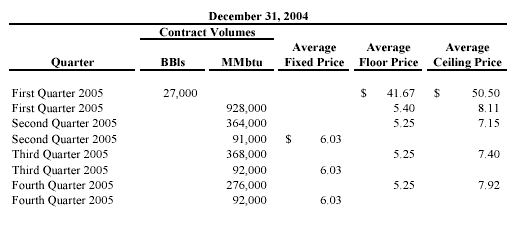| | See “Management’s
Discussion and Analysis of Financial Condition and Results of Operations—Risk
Factors—Natural gas and oil prices are highly volatile, and lower prices will
negatively affect our financial results.” We periodically
review the carrying value of our oil and natural gas properties under the full
cost accounting rules of the Commission. See “—Critical Accounting Policies and
Estimates—Oil and Natural Gas Properties” and “—Risk Factors— We may record ceiling
limitation write-downs that would reduce our shareholders’ equity.” Total
oil purchased and sold under swaps and collars during 2003, 2004 and 2005 were
193,600 Bbls, 121,700 Bbls and 108,500 Bbls, respectively. Total natural gas purchased
and sold under swaps and collars in 2003, 2004 and 2005 were 2,739,000 MMBtu,
3,936,000 MMBtu and 3,892,000 MMBtu, respectively. The net losses realized by
us under such derivative arrangements were $(1.8 million), $(1.0 million) and
$(2.3 million) for 2003, 2004 and 2005, respectively, and were included in oil
and gas revenue for 2003 and mark-to-market gain (loss) on derivative, net for
2004 and 2005. To mitigate some of our commodity price
risk, we engage periodically in certain other limited derivative activities including
price swaps, costless collars and, occasionally, put options, in order to establish
some price floor protection. For derivatives designated as cash flow hedges, we
record the costs and any benefits derived from these price floors as a reduction
or increase, as applicable, in natural gas and oil sales revenue; The costs to
purchase put options are amortized over the option period. We do not hold or issue
derivative instruments for trading purposes. As of
December 31, 2004 and 2005, unrealized gains and (losses) on oil and gas derivatives
of $0.4 million and $(4.3) million, respectively, were included in mark-to-market
gain (losses) on derivatives, net. While the use of
hedging arrangements limits the downside risk of adverse price movements, it may
also limit our ability to benefit from increases in the prices of natural gas
and oil. We enter into the majority of our derivative transactions with two counterparties
and have a netting agreement in place with those counterparties. We do not obtain
collateral to support the agreements but monitor the financial viability of counterparties
and believe our credit risk is minimal on these transactions. Under these arrangements,
payments are received or made based on the differential between a fixed and a
variable product price. These agreements are settled in cash at expiration or
exchanged for physical delivery contracts. In the event of nonperformance, we
would be exposed again to price risk. We have some risk of financial loss because
the price received for the product at the actual physical delivery point may differ
from the prevailing price at the delivery point required for settlement of the
hedging transaction. Moreover, our derivative arrangements generally do not apply
to all of our production and thus provide only partial price protection against
declines in commodity prices. We expect that the amount of our hedges will vary
from time to time. Our gas derivative transactions
are generally settled based upon the average of the reporting settlement prices
on the Houston Ship Channel index for the last three trading days of a particular
contract month. Our oil derivative transactions are generally settled based on
the average reporting settlement prices on the West Texas Intermediate index for
each trading day of a particular calendar month. For the month of December 2005,
a $0.10 change in the price per Mcf of gas sold would have changed revenue by
$0.8 million. A $0.70 change in the price per barrel of oil would have changed
revenue by $146,000. At December 31, 2004 and 2005
we had the following outstanding derivative positions: 
| |